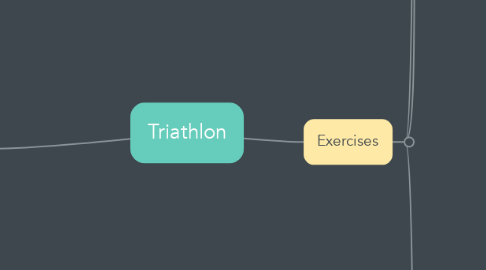
1. Exercises
1.1. Swim
1.1.1. Low Intensity Swims
1.1.1.1. Swim Recovery (SRe)
1.1.1.1.1. workouts used after intense sessions so you're doing something but nothing challenging
1.1.1.2. Swim Foundation (SF)
1.1.1.2.1. you'll do most of your training here to implement the 80/20 balance.
1.1.1.3. Swim Aerobic Intervals (SAe)
1.1.1.3.1. to stimulate the race day intensities of half/full im.
1.1.2. Moderate and High Intensity Swims
1.1.2.1. Swim Cruise Interval (SCI)
1.1.2.1.1. secret weapon
1.1.2.1.2. designed to gain velocity while in Z3
1.1.2.2. Swim Tempo (ST)
1.1.2.2.1. big brother of SCI
1.1.2.2.2. it should be challenging
1.1.2.2.3. common mistake in training ST is starting too fast and fading
1.1.2.3. Swim Mixed Interval (SMI)
1.1.2.3.1. variety
1.1.2.4. Swim Short Interval (SSI)
1.1.2.4.1. tests your ability to hold form in high intensity sessions
1.1.2.5. Swim Speed Play (SSP)
1.1.2.5.1. effective tool for improving critical velocity
1.1.3. Time Trial and Taper Swims
1.1.3.1. meant as maintenance tools to keep you sharp prior to race and not waste you.
1.1.3.1.1. STT1
1.2. Cycling
1.2.1. Low Intensity Workouts
1.2.1.1. Cycling Recovery (CRe)
1.2.1.1.1. used after intense sessions to keep blood flowing
1.2.1.2. Cycling Foundation (CF)
1.2.1.2.1. core of 80/20 plan
1.2.1.2.2. requires discipline and humility
1.2.1.3. Cycling Aerobic Intervals (CAe)
1.2.1.3.1. prepping for the stress of half and full IM races.
1.2.2. Moderate and High-Intensity Cycling
1.2.2.1. Cycling Cruise Intervals (CCI)
1.2.2.1.1. muscular endurance, which is the core ability tested in a triathlon (aside from mind control).
1.2.2.1.2. while in Z3 training, reduce rest from 3min to 2min to 1min
1.2.2.2. Cycling Tempo (CT)
1.2.2.2.1. develops muscular endurance. simulates sprint and oly distance races.
1.2.2.3. Cycling Fast Finish (CFF)
1.2.2.3.1. cultivates the ability to ride hard on tired legs
1.2.2.4. Cycling Force (CFo)
1.2.2.4.1. build pedaling efficiency and power
1.2.2.4.2. go very hard
1.2.2.4.3. ride in high gear/ reduce cadence to 65-75rpm
1.2.2.4.4. pedal occasionally from standing position
1.2.2.5. Cycling Mixed Intervals (CMI)
1.2.2.5.1. challenging workout
1.2.2.5.2. designed to increase lactate threshold and aerobic capacity
1.2.2.5.3. there may be suffering involved
1.2.2.6. Cycling Anaerobic Intervals (CAn)
1.2.2.6.1. most effective way to increase aerobic capacity or VO2Max
1.2.2.7. Cycling Speed Play (CSP)
1.2.2.7.1. Z5 and similar to CF rides
1.2.2.7.2. don't push too hard and fade
1.2.2.8. Bricks (BR)
1.2.2.8.1. reserved for finals weeks leading up to the event
1.2.2.8.2. pure race simulation
1.2.2.8.3. long, instense Z3 are best dress rehearsals
1.3. Running
1.3.1. Low-Intensity Runs
1.3.1.1. Running Recovery (RRe)
1.3.1.1.1. gentle aerobic stimulus
1.3.1.2. Running Foundation (RF)
1.3.1.2.1. most common workout in tri training
1.3.1.2.2. consider Z2 the "vegetables" of your training diet
1.3.1.3. Running Aerobic Intervals (RAe)
1.3.1.3.1. aim for end of Z2
1.3.1.3.2. Z2 speed = half IM speed
1.3.2. Moderate and High-Intensity Running
1.3.2.1. Running Cruise Intervals (RCI)
1.3.2.1.1. a bread and butter session
1.3.2.1.2. a Z3 workout done near the lactate threshold
1.3.2.1.3. practicing this pace will allow you to hold it at that zone longer and more efficient
1.3.2.2. Running Tempo (RT)
1.3.2.2.1. stimulates intensity
1.3.2.2.2. verify lactate threshold
1.3.2.3. Running Fast Finish (RFF)
1.3.2.3.1. develop ability to run fast while fatigued
1.3.2.4. Running Hill Repeats (RHR)
1.3.2.4.1. adds power and efficiency to your stride
1.3.2.4.2. use perceived effort to gauge Z5 as HRM and combined with short duration will not accurately gauge the effort level.
1.3.2.4.3. on Treadmill, set incline to 6-8%
1.3.2.5. Running Mixed Intervals (RMI)
1.3.2.5.1. complex in execution but rewarding if done correctly
1.3.2.5.2. should feel agony/suffering
1.3.2.5.3. remember pain is temporary
1.3.2.5.4. this will improve run splits
1.3.2.6. Running Anaerobic Intervals (RAn)
1.3.2.6.1. increased aerobic capacity and improved running economy
1.3.2.6.2. best used in early stages of training cycle
1.3.2.6.3. intense workout, not to be performed more than 1x a week
1.3.2.7. Running Short Intervals (RSI)
1.3.2.7.1. unlike hill repeats, this is done on flat surface
1.3.2.7.2. go as hard as you want
1.3.2.7.3. can be used in place of RHR
1.3.2.8. Running Speed Play (RSP)
1.3.2.8.1. provides moderate stimulus for aerobic development
1.3.2.8.2. don't go to Z5
1.3.2.9. Run Taper (RTa)
1.3.2.9.1. used around race weeks to help you stay sharp
2. Notes
2.1. 80/20 rule
2.1.1. 80% low intensity
2.1.2. 20% high intensity
2.1.3. don't get into the moderate intensity rut
2.1.3.1. you're fatigued
2.2. the faster you go through the 80/20 training, the faster you'll get
2.3. High Cadence in Cycling
2.3.1. will help with glycogen
2.3.2. 90prm is goal for cycling (adjust resistance to get to 90)
2.4. identify your VT
2.5. back in the days (prior to mark allen). Tri was more adventurous mindset than competitive.
2.5.1. mark allen dominated the tri for 14 years via low intensity.
2.6. elite triathletes train around 3 hrs per day
2.6.1. because they are training at low intensity
